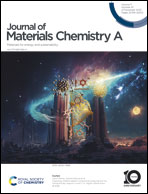Deep reconstruction of Ni–Al-based pre-catalysts for a highly efficient and durable anion-exchange membrane (AEM) electrolyzer†
Abstract
The anion exchange membrane (AEM) electrolyzer has shown great potential for producing green hydrogen. However, this technology is still in its early stages and has not yet been applied on an industrial scale. One of the most significant challenges is the lack of cost-effective and scalable techniques for producing highly active, durable, and earth-abundant metal-based catalysts. Herein, we present a scalable thermal spraying process for fabricating defect-rich nickel-based HNA-CA that can function as an efficient pre-catalyst for both (hydrogen evolution reaction) HER and (oxygen evolution reaction) OER. Particularly, after deep reconstruction through simple electrochemical activation, the obtained HNA-CA-H and HNA-CA-O exhibit the lowest overpotential of −31 mV (HER) and 188 mV (OER) at 10 mA cm−2, surpassing that of noble metal-based catalysts such as Pt and IrO2, respectively. By coupling two 5 cm2 electrodes, the resulting HNA-CA-H(–)‖HNA-CA-O(+) AEM electrolyzer cell demonstrates exceptional performance, achieving an extraordinarily low cell voltage of 1.89 V at 1 A cm−2 (1 M KOH, room temperature). Furthermore, it showcases remarkable durability, sustaining operation for an impressive 500 hours at 5 A (1 A cm−2). These performance metrics notably outclass the majority of AEM electrolyzers reported under comparable operational settings. The outcomes can primarily be ascribed to the substantial improvements in interfacial contact, charge transfer efficiency, and mass transport mechanisms, all of which were comprehensively unveiled through in situ impedance analysis, ex situ structural characterization, and a thorough investigation of wettability and bubble dynamics. These findings hold significant promise for expediting the advancement and practical deployment of AEM electrolysis technology.



 Please wait while we load your content...
Please wait while we load your content...